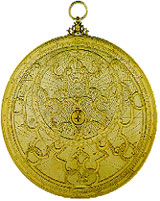|
Nautical Astrolabe
The astrolabe is an ancient device used to measure angles and serving, namely, to measure the height of stars above the horizon. Its invention is attributed to Hipparchus, considered by some to be the father of astronomy and trigonometry. Ptolemy calls the astrolabe an armillary sphere, which the Arabs combined with the celestial globe and perfected, thus creating the spherical astrolabe. The planispheric astrolabe is a simplification, which results in a polar stereographic projection of the celestial sphere onto a plane. The Greeks knew it, but it was through the Arabs, who introduced it in the Iberian Peninsula, that it came to be known in Europe.
The nautical astrolabe was a simplification of the planispheric one and it could only measure the height of the Sun or stars. Initially it had the shape of the posterior face of the planispheric astrolabes. However, it gained a new shape due to the experience amassed by the pilots. It no longer was made of metal sheet or wood and was instead made of a copper alloy, so that its weight was less subject to the swinging of the ship. The initial disk was partially open to diminish the resistance to the wind. The definitive shape of the nautical astrolabe is then a circle with two orthogonal diametres in the centre of which gyrates an alidade. This alidade has two pinhole sights which should be aligned with the star. On one of the extremes the alidade pointer intercepts a 0-90 degree scale ... on the top quadrants of the circle.
Links
Museu da Marinha - Sala dos Descobrimentos
Museu do Observatório Astronómico da Universidade de Coimbra
Associação Nacional de Cruzeiros - Astrolábio Náutico
|
|
|





